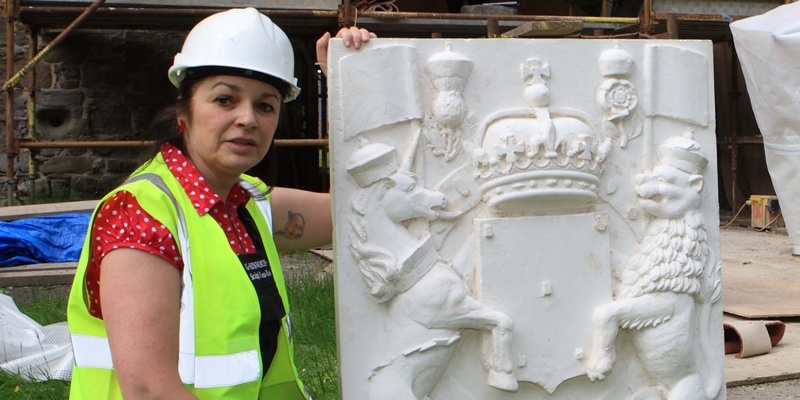One of the country’s most respected sculptors has spoken of her ”honour” at being chosen to recreate the jewels in Scone Palace’s crown.
Graciela Ainsworth was this week given the go-ahead to start work on the new centrepieces of a historic archway at the former coronation site of Scottish kings.
The original armorial panels, and much of the 16th century structure, were destroyed in a freak accident involving a workman’s van in 2010.
The Edinburgh-based artist is part of a team of conservation experts carefully selected to resurrect the iconic arch, which was all that remained of the approach to the Augustinian abbey.
Experts at the time likened the repair to ”completing the ”world’s largest jigsaw puzzle” but it is now hoped it will be completed by next spring.
Ms Ainsworth, who owns Graciela Ainsworth Sculpture Conservation, has worked on high-profile restorations at Stirling Castle and the Queen’s Gallery in Edinburgh and recently discovered she has won a contract at Hampton Court in Herefordshire next year.
But she describes the Perthshire project as one of her most significant to date.
”I work with Historic Scotland quite a bit so when the archway was knocked down I was asked to attend the palace to give my opinion on what could be salvaged.
”It was awful to see a piece of history so badly damaged but everyone has always been determined to restore it to its full glory.
”I was so honoured when my tender was selected and have been in regular contact with the Stormont family (who own the estate) to ensure the panels are as close to the originals as possible.”
Continued…
She continued: ”I have the damaged panels in my workshop it’s important to me to use them as a guide.
”Myself and William Murray, Master of Stormont, have been using magnifying glasses to work out exactly what carvings went where and what they looked like.
”I will also be doing the work by hand, using techniques and equipment similar to that used all those years ago.
”I have an incredible respect for the original carvers and want to get a grasp of the hands that worked in the 1500s.”
The two panels and the archway are to be constructed using sandstone from the Borders. The surviving panels at the side of the structure will be strengthened to ensure they also withstand the test of time.
Central to the central palace-facing panel is the ancient Royal Scottish Coat of Arms, flanked by a lion and a unicorn.
The motto of the legendary Knights Garter Honi soit qui mal y pense, which, translated, means Evil to him who evil thinks circles the crest and symbols of Scotland, England and France can all be seen.
The opposite panel, thought to have been designed a number of years earlier, is more traditionally Scottish and unique to Scone. The dictum In defence we defend frames the piece.
The van driver had been collecting a marquee from the palace on September 27 2010 following the Perth Hunt Ball when his vehicle struck the large archway.
Masonry was thrown many metres but miraculously no-one was injured.
Speaking in April, William Murray said: ”It was this very, very important archway very significant to the family and also to Scottish history, primarily because of the timing of it.”
The repair programme, led by conservation engineer John Addison, is expected to cost in excess of £150,000. St Andrews-based firm WL Watson and Sons will carry out the majority of the stonemasonry and structural work.
Scone was as an ancient gathering place of the Picts and it is believed the palace grounds were the site of an early Christian church.
The current Scone Palace, a red sandstone A-listed building, was built in 1808 for the earls of Mansfield by William Atkinson. However, in the Middle Ages the land was the home of the Augustinian Scone Abbey the crowning place of Scottish kings.
Photo by Phil Hannah
